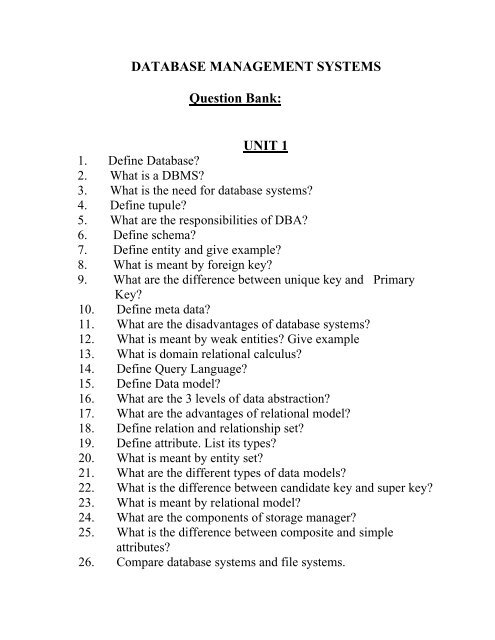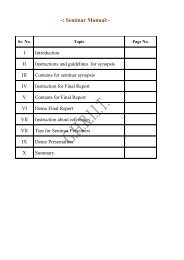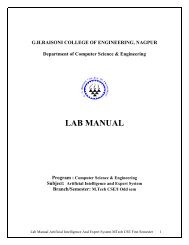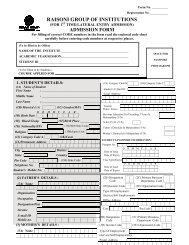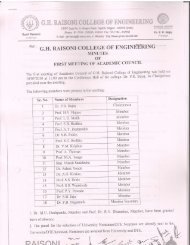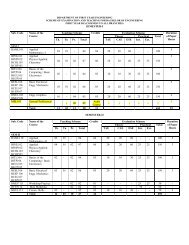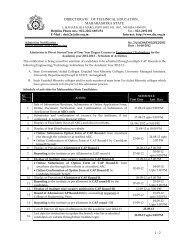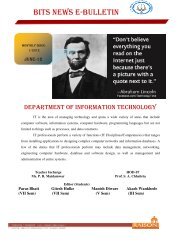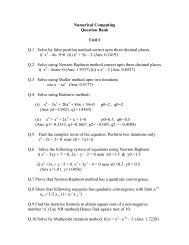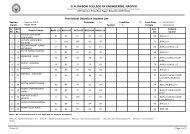DATABASE MANAGEMENT SYSTEMS Question Bank ... - Raisoni
DATABASE MANAGEMENT SYSTEMS Question Bank ... - Raisoni
DATABASE MANAGEMENT SYSTEMS Question Bank ... - Raisoni
You also want an ePaper? Increase the reach of your titles
YUMPU automatically turns print PDFs into web optimized ePapers that Google loves.
<strong>DATABASE</strong> <strong>MANAGEMENT</strong> <strong>SYSTEMS</strong><br />
<strong>Question</strong> <strong>Bank</strong>:<br />
UNIT 1<br />
1. Define Database?<br />
2. What is a DBMS?<br />
3. What is the need for database systems?<br />
4. Define tupule?<br />
5. What are the responsibilities of DBA?<br />
6. Define schema?<br />
7. Define entity and give example?<br />
8. What is meant by foreign key?<br />
9. What are the difference between unique key and Primary<br />
Key?<br />
10. Define meta data?<br />
11. What are the disadvantages of database systems?<br />
12. What is meant by weak entities? Give example<br />
13. What is domain relational calculus?<br />
14. Define Query Language?<br />
15. Define Data model?<br />
16. What are the 3 levels of data abstraction?<br />
17. What are the advantages of relational model?<br />
18. Define relation and relationship set?<br />
19. Define attribute. List its types?<br />
20. What is meant by entity set?<br />
21. What are the different types of data models?<br />
22. What is the difference between candidate key and super key?<br />
23. What is meant by relational model?<br />
24. What are the components of storage manager?<br />
25. What is the difference between composite and simple<br />
attributes?<br />
26. Compare database systems and file systems.
27. Give the distinction between primary key, candidate key and<br />
super key.<br />
28. What is derived attribute? Give an example?<br />
29. What is the difference between Weak and strong entity set?<br />
30. What is the difference between a procedural and nonprocedural<br />
languages?<br />
UNIT 2<br />
1. What are the disadvantages of DBMS compare to file processing<br />
systems? Explain in detail?<br />
2. Draw a system architecture of DBMS. Explain each component<br />
in detail.<br />
3. Explain various types of data models in detail.<br />
4. Compare network and hierarchical model. Explain with example?<br />
5. What is meant by E-R model? Explain with e.g.<br />
6. What are the various types of attributes? Explain each with<br />
example?<br />
7. Write detail notes on relational algebra.<br />
8. Explain domain and tuple relational calculus in detail.<br />
9. What is the need of relational model? Explain with example?<br />
10. List the different types of database users with their roles.<br />
11. What is the role of DBA in the DBMS?
UNIT 3<br />
1. What is data ?<br />
2. Describe database ?<br />
3. What is database management system ?<br />
4. What is RDBMS ?<br />
5. Write full form of SQL ?<br />
6. Describe Relational model ?<br />
7. Write three views of three level architecture ?<br />
8. Explain Data models ?<br />
9. SQL is the combination of _ and _ .<br />
10. Define data dictionary ?<br />
11. Define the following terms:<br />
DDL & DML ?<br />
12. Define schema ?<br />
13. Define schema instance ?<br />
14. What are the basi units of ER diagrams ?<br />
15. Describe primary key ?<br />
16. Describe foreign key ?<br />
17. Describe candidate key ?<br />
18. Explain data integrity ?<br />
19. Briefly describe entity integrity ?<br />
20. Briefly describe referential integrity ?<br />
21. Define week entities ?<br />
22. Define relational database ?<br />
23. What is specialization ?<br />
24. What do you mean by identifier ?<br />
25. Define relational schema ?<br />
26. What do you mean by unary relation ?<br />
27. What are the function of selection and projection operation ?<br />
28. What is data abstraction ?<br />
29. Briefly describe the concept of metadata ?
30. What do you mean by cardinality ?<br />
31. Define the following terms :<br />
a. tuple<br />
b. Domain<br />
32. Define the following terms :<br />
a. Field<br />
b. Record<br />
33. What do you mean by information ?<br />
34. What is data redundancy ?<br />
35. Describe DCL ?<br />
36. Describe DDL ?<br />
37. Describe DML ?<br />
38. Various operations use in relational algebra.<br />
39. Various operations use in relational calculas.<br />
40. What are the various features of join operations ?<br />
41. What are various data types use in SQL ?<br />
42. Is SQL non procedural language ?<br />
43. Why tuples are used in relational model ?<br />
44. What is the other two name of attribute ?<br />
45. What is the function of update and delete command ?<br />
46. What do you mean by composite key ?<br />
47. What do you mean by dependent and independent entities ?<br />
48. What is an entity set ?<br />
49. Describe regular entities ?<br />
50. What do you mean by Hierarchical model ?<br />
51. What do you mean by key ?<br />
52. Write types of keys ?<br />
53. What do you mean by integrity constraints ?<br />
54. What do you mean by procedural DML ?<br />
55. What is query processing ?<br />
56. What is the function of parser in query processing ?<br />
57. What is file organisation ?<br />
58. What are direct files ?<br />
59. What do you mean by hashing ?<br />
60. What do you men by transaction processing ?
61. What do you mean by B-tree ?<br />
62. Briefly describe file processing ?<br />
63. Briefly describe Data base processing ?<br />
64. Name all the models available for database system ?<br />
65. Write down the two difference between DBMS & RDBMS ?<br />
66. What is Normalization ?<br />
67. What do you mean by data dictionary ?<br />
68. Write down the four components of DBMS ?<br />
69. Write down the four components of DBMS environment ?<br />
70. Write down the full forms of CASE tools ?<br />
71. What is DOMAIN ?<br />
72. What is domain value ?<br />
73. Write different types of constraints ?<br />
74. What is the difference between numeric and float data type in SQL<br />
?<br />
75. What is Query optimization ?<br />
76. What are the two function of DB manager ?<br />
77. Different types of users .<br />
78. Where we store data structure in DBMS ?<br />
79. Where we have to change in data when changes occur in data ?<br />
80. Briefly describe client server model ?<br />
81. What do you mean by null constraints ?<br />
82. What is metadata ?<br />
83. What are the basic units of E-R diagrams ?<br />
84. What do you mean by attribute ?<br />
85. What do you mean by SQL ?<br />
86. Describe distributed DBMS ?<br />
87. Briefly describe application programmers ?<br />
88. What do you mean by comparison operator ?<br />
89. Different types of select query ?<br />
90. Two comparison b/w Network and relational model ?<br />
91. How does a view differ from a table ?<br />
92. Describe object oriented approach ?<br />
93. Why drop query is used ?<br />
94. Full form of BCNF ?
95. What is the difference b/w 3NF and BCNF ?<br />
96. What is meant functional dependency ?<br />
97. What is the need of normalization ?<br />
98. What do you mean by mapping operation ?<br />
99. What is the difference b/w procedural and non procedural query<br />
languages ?<br />
100. What do you mean by degree of relationship set ?<br />
UNIT 4<br />
Q1. What do you mean by cardinality? What are different kinds of<br />
cardinalities ?<br />
Q2. Define DDL<br />
(b) DML<br />
Q3. What is a primary key ?<br />
Q4. What are various Data types in SQL ?<br />
Q5. What is relation ? Define the relational data model.<br />
Q6. What do you mean by SQL ?What are the characteristics of SQL ?<br />
Q7. What is the role of Database Administrator ?<br />
Q8. What do you mean by Database and Database Management System ?<br />
Q9. What are problems with traditional file processing system ?<br />
Q10. What do you mean by Data processing ?<br />
Q11. What is meant by an entity, attributes, entity set and relationship ?<br />
Q12. How is E-R data model useful ?<br />
Q13. Define an attribute. What is a key attribute ?<br />
Q14. Define subtype and supertype entities ?<br />
Q15. Give example of following relationships :<br />
(i) Many-to-One<br />
(ii) One-to-One
(iii) One-to-Many<br />
(iv) Many-to-Many<br />
Q16. Define foreign key ? How does it play a role in the join operation ?<br />
Q17. What do you mean by Mapping Operation ?<br />
Q18. What do you mean by redundancy ?How this can be avoided ?<br />
Q19. What do you mean by Normalisation ? Why this is useful ?<br />
Q20. What is the difference between Procedural DML and Non-<br />
Procedural DML ?<br />
Q21. What do you mean by instance & schema ? Explain the difference<br />
between these.<br />
Q22. What are the various components of a database system ?<br />
Q23. What is the role of three levels of Data Abstraction ?<br />
Q24. How is a many-to-many relationship mapped onto a table ?<br />
Q25. What do you mean by a key ? Explain the difference between<br />
primary key and Candidate key.<br />
Q26. What is the difference between the strong entity set and weak entity<br />
set ?<br />
Q27. Give SQL statement which creates a STUDENT table consisting of<br />
following fields.<br />
Name CHAR(40)<br />
Class CHAR(6)<br />
Marks NUMBER(4)<br />
Rank CHAR(8)<br />
Q28. What is a relation ? What is the difference between a table and an<br />
attribute.<br />
Q29. If R1 is a relation with 5 rows and R2 is a relation with 3 rows, how<br />
many rows will the Cartesian product of R1 and R2 have ?
Q30. Which subdivision of SQL is used to put values in tables and which<br />
one to create tables ?<br />
Q31. Why Data Control Language (DCL) is used ? Explain.<br />
Q32. Explain the type of relationship the following have :<br />
(iii) Student and ID card<br />
(iv) Customer and <strong>Bank</strong><br />
(v) Student and Roll No<br />
(vi) Customer and Car<br />
Q33. Differentiate between SQL commands DROP TABLE and DROP<br />
VIEW.<br />
Q34. Is Data Dictionary an essential part of DBMS. Why ?<br />
Q35. What is meant by the term Query Processing ? What are the various<br />
steps involved in this process ?<br />
Q36. What is the difference between WHERE and Having Clause ?<br />
Q37. What is file organization ? Explain Sequential-files and direct-Files<br />
?<br />
Q38. Differentiate between First Normal form and Second Normal form.<br />
Q39. What is a multivalued dependency ? What kind of constraint does it<br />
specify ?<br />
Q40. Discuss the various type of join operations ? Why are these join<br />
required.<br />
Q41. List the operations of relational algebra and purpose of each.<br />
Q42. What is the difference between tuple relational calculus and domain<br />
relational calculus?<br />
Q43. SQL is called as non-procedural language. Explain ?<br />
Q44. What you mean by attribute ? Explain various type of attributes.<br />
Q45. Define the following terms :<br />
(a) Tuple (b) Domain<br />
(c) Relation (d) Entity<br />
(e) Regular entities
Q46. What is the difference between select and project operation ? Give<br />
example.<br />
Q47. Explain the concept of metadata.<br />
Q48. What is the need for Normalisation ? Define Third Normal form.<br />
Q49. Explain the term Distributed DBMS and Client-Server DBMS.<br />
Q50. What do you mean by Hashing ?<br />
Q51. What is integrity ?<br />
UNIT 5<br />
1) What is ER Diagram? What are the symbols used is it?Explain with<br />
an example.<br />
2) What is the need of the normalization? Explain the first three steps<br />
involed in the normalization.<br />
3) List out all the Codd’s rules.<br />
4) What do u mean by the database abstraction?how many types are<br />
there?<br />
5) Difference between file oriented approach and database<br />
management.<br />
6) Difference between Database systems and Knowledge base systems.<br />
7) Explain the client server architechure in detail.<br />
8) What is the architecture of the database.Explain with diagram.<br />
9) What is DBA,wht are DBA’s functions?<br />
10) Draw the ER diagram for the banking system.<br />
11) What is query processing .explain the various steps involved<br />
in it.<br />
12) What is database management system, what are its<br />
characteristics? What is the need of database management .<br />
13) What is structured query language? How the DDL and DML<br />
are different?explain.<br />
14) What is the file system.Explain the sequential files and direct<br />
files.<br />
15) What are the drawbacks of the file systems.Explain in detail.<br />
16) What is the data reduncdancy?how to remove the data<br />
redundancy?explain any
UNIT 6<br />
Q1. What are various components of Database System ? Explain in<br />
detail.<br />
Q2. What do you mean by data models ? Explain network, hierarchical<br />
and relational model in detail.<br />
Q3. Explain various levels of Data abstraction in database system ?<br />
Q4. What do you mean by database ? What is the purpose of a database<br />
system ? Explain.<br />
Q5. What do you mean by DBMS ? Explain its functioning.<br />
Q6. Explain architecture of DBMS and its advantages ? state two main<br />
disadvantages of DBMS ?<br />
Q7. What is DBA ? What are major responsibilities of DBA and database<br />
designers ?<br />
Q8. What are problems with traditional file processing system ? How<br />
they are removed in database system ? Explain<br />
Q9. What do you mean by Entity-Relationship Diagram ? Explain<br />
Q10.Explain the various terms of an E-R model and how are they<br />
represented in an E-R model ?<br />
Q11.What is meant by term relationship between entities ? Explain the<br />
different types of relationships that can exist with examples ?<br />
Q12.Explain the concept of dependent entities ? give example.<br />
Q13.What do you mean by mapping cardinalities ? Explain various type<br />
of cardinalities.<br />
Q14.What is difference between total and partial participation ? Explain.<br />
Q15.What is the difference b/w single and multivalued attributes ?<br />
Explain.<br />
Q16.Explain the concept of participation constraints ?<br />
Q17.Discuss the various update operation on relation and types of<br />
integrity constraints that must be checked for each update operation ?
Q18.Discuss the various types of join operations ? Why are these join<br />
required ?<br />
Q19.What do tyou mean by normalization ? Explain.<br />
Q20.What do you mean by BCNF ? Why it is used and how it differ from<br />
3 NF ?<br />
Q21.Describe the three-level architecture of DBMS ? Also explain its<br />
importance in a database environment.<br />
Q21. Discuss concept of database language and interfaces.<br />
Q22. Give the various advantages and disadvantages of the network<br />
model.how it differ from relational model ?<br />
Q23. What is relationship ? What are various types of relationship ?<br />
Explain with example.<br />
Q24. Explain the Codd’s Rule in detail.<br />
Q25. What do you mean by RDBMS ? What are its characteristics ?<br />
Q26. Explain Entity integrity and Referential integrity in detail.<br />
Q27. What is the difference between DBMS and RDBMS ? Which of<br />
them is more suitable?<br />
Q28. What is relational algebra ? Discuss the various operations of<br />
relational algebra.<br />
Q29. Describe the different types of relational calculus in detail.<br />
Q30.What dis relational calculus ? Differentiate relational algebra and<br />
relational calculus.<br />
Q31. What do you mean by Null values? Explain with suitable examples.<br />
Q32. Why normalization needed ? What are its disadvantages ?<br />
Q33..Discuss the various normal form in normalization with suitable<br />
examples.<br />
Q34. Define term anomalies.Explain BCNF in detail.<br />
Q35. Why is concurrency control needed? Explain lost update,<br />
Inconsistent retrievals and uncommitted dependency anomalies.<br />
Q36. What is a deadlock ? How can a deadlock occur ? explain.<br />
Q37. Briefly explain one deadlock prevention algorithm.<br />
Q38. What if time stamping is used ? Explain briefly<br />
Q39. What is two-phase locking and how does it guarantee serializability<br />
?
Q40. Discuss the concurrency control mechanism in detail using suitable<br />
example.<br />
Q41. Differentiate between Two phase locking and Rigorous two-phase<br />
locking.<br />
Q42. How can deadlocks be avoided when using 2PL?<br />
Q43. How Share and exclusive locks differ ?Explain.<br />
Q44. How precedence graph can be used to detect deadlock ?<br />
Q45. What is a system log ? What is the purpose of the system log in<br />
system recovery ?<br />
Q46. What do you understand by distributed databases? Give the various<br />
advantages and disadvantages of distributed database management<br />
system.<br />
Q47. Explain the architecture of Client-Server databases in detail.<br />
Q48. What are the main differences between a parallel and a distributed<br />
system ? Explain.<br />
Q49.Discuss the concept of Query Processing .What is a parser ? Why it<br />
is used ?<br />
Q50.What is Query optimization ?What are different techniques used in<br />
it.
DBMS QUESTION BANK<br />
1. Write the difference between Database systems Vs File system<br />
2. Explain View of Data.<br />
3. Define the following terms<br />
(a). Instances (b) schemas (c) logical schema (d) physical<br />
schema<br />
4. Explain Briefly about Data Models<br />
(a) E-R model (b) Relational Model (c) Object-Oriented<br />
Model<br />
5. Explain Database languages<br />
(a) DDL (b) DML (c) Database access from Application<br />
programs<br />
6. Explain Database Users and Administrators<br />
7. Explain Transaction Management.<br />
8. Briefly explain Database system Structure<br />
9. Explain Entity sets and Relationship Sets.<br />
10. Explain Attributes and its types with examples.<br />
11. Explain Constraints and its types with examples.<br />
12. Explain Mapping Cardinalities with example.<br />
13. Define keys and its types with examples.<br />
14. Explain Overall logical structure of E-R Diagram.<br />
15. Explain Symbols used in the E-R notation.<br />
16. Define UML and symbols used in UML notations.<br />
17. Explain Relational Algebra and explain all its Fundamental<br />
operations with examples.<br />
18. Explain Composition Operations in Relational Algebra.<br />
19. Explain Formal Definition of the Relational Algebra.<br />
20. Explain Views with examples.<br />
21. Explain Tuple Relational Calculus with all operations. Explain<br />
Difference between Tuple Relational Calculus with Relational<br />
Algebra.<br />
22. Explain Domain Relational Calculus with example. And state<br />
the difference between this and Tuple relational calculus.
23. What is Join and its types with example queries.<br />
24. What is embedded-sql with example.<br />
25. Explain Assertion with examples.<br />
26. Explain Cursor and its types with examples.<br />
27. Explain Security and its Violations with examples.<br />
28. Explain Authorization with examples.<br />
28. Define 3NF with examples.<br />
29. Define Domain constraints ?<br />
30. Explain Referential Integrity constraints with example ?<br />
31. Is Database Modification Violates Referential integrity ?<br />
32. Define Assertions with example ?<br />
33. Explain Triggers with examples ?<br />
34. Explain Triggers in SQL ? and its types with examples. ?<br />
35. Explain when not to use Triggers ?<br />
36. Explain Security Violations with examples.<br />
37. Explain Authorization ?<br />
38. Explain Granting of Privileges ?<br />
39. Define Audit trail with example ?<br />
40. Explain Authorization in SQL ?<br />
41. Explain First Normal Form with example ? (*)<br />
42. Explain Functional dependency and full-functional<br />
dependency ? (*)<br />
43. Explain Decomposition and its properties ? (*)<br />
44. Explain Boyce-codd normal form with example ? (*)<br />
45. Explain Third normal form with example ? (*)<br />
46. Explain Fourth normal form with example ? (*)<br />
47. State the difference between Boyce-codd normal form and<br />
third normal form ?<br />
48. Explain Extraneous attributes ?<br />
49. Explain referential integrity, DB modification with on delete<br />
cascade and on update<br />
50. Explain Triggers and its types with examples.<br />
51. Explain Authorization in SQL with examples.<br />
52. Explain Functional dependency and Trivial functional<br />
dependency with examples.
53. Explain Fourth normal forms with examples.<br />
54. Explain Closure of Set of Functional dependency and Closure<br />
of Attribute sets<br />
55. Explain Canonical cover and Extraneous Attributes with<br />
examples.<br />
56. Explain BCNF with examples and also state the difference<br />
between this from 3NF.


